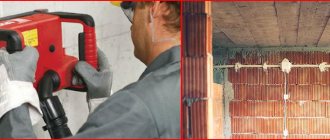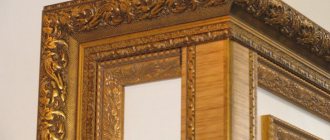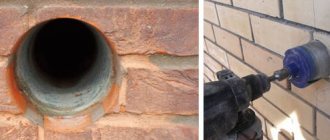Hiding wires in the wall
At the renovation stage, you can hide the wires from the TV in the wall. To do this, you need to accurately determine the permanent place of “residence” for the television panel.
Next, starting from the intended location of the wire, make a channel in the wall towards the electrical point and lay the cable. Use special construction staples to securely fix it, and then carefully cover it with plaster. Now you can start finishing work.
This method has one significant drawback - the television panel loses its mobility. If you need to move it to another location or send it in for repairs, removing the wire will be very problematic.
Slitting process
Why bother with “disguising” the electrical wiring if you can first attach it to the main wall, and then simply plaster it on top. The technique is called “hidden” and the sequence of actions is not always exactly the same. Most often, a team of plasterers does their job valiantly, and then they are replaced by electricians who begin to reformat the world in their own way, in accordance with the tasks assigned to them. This is strongly reminiscent of the joke about two soldiers from a construction battalion, one of whom was digging holes, and the other was burying them after him (there was no third one, who was supposed to plant trees, but an order is an order). To carry out wiring, electricians are forced to make channels for wires and holes in the plaster with a hammer drill - to punch the surface.
Not everyone and not always want this burdensome procedure:
- Scoring damages existing plaster. It is extremely rare to be able to break through neat channels. And even if this can be done, the final layer of plaster in the areas of gating will still have to be restored after laying the cable. It is worth recognizing that the technique is very multi-iterative.
- Grooving is associated with increased generation of dust, which will be everywhere in the apartment. If we are not talking about the initial arrangement, but about repairs, then you will definitely have to re-glue the wallpaper and update the ceiling.
- Long-term unpleasant sound impact of a hammer drill. Even if you carry out repair work at strictly prescribed hours by law, your neighbors will still not thank you.
- The wiring turns out to be completely hidden. There will never be access to it now.
The purpose of the thesis of this section is not at all to discredit one of the most universal construction technologies that provides great opportunities (slating)
In relation to electrical wiring, I would like to emphasize that the design and aesthetic appeal of the method comes at the price of safety. Electricity is not something to be trifled with, and communications tend to fall into disrepair
It would be good to replace them. But if the wires in the apartment are laid in channels drilled into the wall, then you can simply forget about it. Replacing the wiring is only possible by laying a new cable and disconnecting the old one (at both ends).
In this regard, it would be nice, of course, to get an alternative. There is such a way - it is laying electrical cables in an open way. The features and capabilities of this path are described below.
Masking with a cable channel
Use a camouflage box. With its help you will hide television wires without disturbing the surface of the wall. This structure is fastened with hidden screws and liquid nails.
Today you can purchase a cable channel model that best suits the style of the room. The simplest type is an ordinary plastic box, which after installation can be covered with the same finishing material as the entire wall.
There are models lined with decorative bricks or in the form of pipes, which are ideal for interiors in loft and hi-tech styles. For classic or eco-trends, you can choose wooden or MDF models.
Installation of the junction box
There are some nuances here too. It’s worth starting with the fact that in rooms with concrete walls it is recommended to use diamond-coated drill bits, since the more common models with pobedit coating wear out quickly, and you will have to buy additional drills. They can only be used in houses with walls made of finblocks. Typically, when working with finblocks, it is prohibited to use diamond-coated crowns for the same reasons.
Before milling begins, a hole with a diameter equal to the drill is made in the center of the installation, which will make the work much less difficult. Experts recommend choosing boxes with a diameter of 6-7 cm; this will be quite enough for 6 cores. If you plan to connect several sockets in a row, the place for them is leveled.
Hiding behind drywall
Drywall is widely used in the design of modern interiors, as it allows you to mask surface imperfections and create original decorative designs. Why not take advantage of this?
Come up with a wall structure, for example, in the form of a plasterboard box with niches, shelves and, of course, space for a television panel. After installation, all wires will be securely hidden, and the interior of the room will become more stylish and functional.
You can build a false fireplace from drywall and install a TV above it. This way you will get a great seating area, and the wires will be securely hidden.
Useful tips
Remember that electrical cords are potentially dangerous, so do not use them longer than required. Twisting and weaving are not permitted as this increases the risk of fire as well as the chance of electric shock. If you have to use many wires in one place, it is better to label them to avoid confusion. Finally, separate the electrical power wires from the “low current”, usually responsible for the Internet and communications. Otherwise you will get a lot of interference.
How to hide wires in furniture
The TV can be installed in a wall set, which will hide all communications in its depths. But if you don’t like bulky structures, use modular elements, such as a wall cabinet.
Many modern models of such furniture already have special holes in their design into which wires are laid.
Stretch ceilings in the interior of an apartment (200 photos)
Wire panel
If you are a creative person, come up with some kind of wall drawing, the contours of which you will draw with wire. You can find quite a lot of such ideas on the Internet!
Draw a sketch on the wall with a pencil and start laying. Don’t forget that the pattern or geometric figure should fit harmoniously into the interior.
An important point is the method of fixation. Nails are not suitable for this work - they can damage the cable and spoil the design with their unaesthetic appearance. Therefore, use double-sided tape or glue.
Lamps
Today, the installation of spotlights in a house or apartment is becoming increasingly popular. As a rule, there are more than 4 spots on the ceiling, so there are quite a lot of wires to connect them. There are several ways to hide unnecessary things from view, depending on the type of ceiling in the room. The easiest way is if the ceiling is suspended, because... in this case, you can disguise the wires with the ceiling film itself. If the ceiling covering is plasterboard, you can hide the wiring only under plasterboard sheets, inside the frame. Read about how to conduct wiring under drywall in our separate article: https://samelectrik.ru/kak-provesti-elektroprovodku-pod-gipsokartonom.html.
If all the wiring from the chandelier is hidden in the lamp body, then the cord for connecting the sconce is a little more difficult to hide. If the wall is bare, you can decoratively hide the hanging wire by extending it and making a design on the wall. You can see an example of such an idea in the photo:
Masking with vinyl stickers
Interior vinyl stickers are an excellent decorative material. Its main advantage is that it allows you to quickly transform the interior and emphasize style. At the same time, such decor can be removed or replaced with a new one at any time without any problems.
Use vinyl stickers to create decorations where the TV cable is located. It could be a branchy tree, with the crown of which the cable will blend into the color palette.
Wires behind a wooden panel
Installing a wooden panel with a TV will not only adequately highlight the design of the room, but will also become an excellent camouflage element that will allow you to hide the wires.
Wooden panels can have a different color palette and shape, adding sophistication and presentability to the interior. In addition, the material will serve as a good sound insulator, so you won’t have to worry about the indignation of picky neighbors who are dissatisfied with the increased volume.
60+ beautiful narrow bedroom design ideas (photos)
Branches of dry and artificial plants
Wires from the TV can also be hidden using branches of artificial plants. Place a vase with dry twigs near or under the TV panel and all attention will shift to an attractive-looking composition.
You can use special wire covers in the form of branches, which are quite similar in design to cable channels, but at an aesthetic level they are much superior. Such functional decor will look great in a children's room.
Internal placement
When a major renovation begins in an apartment or house, the wiring is most often recessed into the walls. First, using a wall chaser, drill, or hammer drill, grooves are made in the wall, into which the cables are then hidden. Wiring in a wooden house must be placed in a protective corrugation - a shell that will protect them from adverse effects and prevent damage.
On the walls
It happens that the wallpaper is already pasted, and you don’t want to violate its integrity. There is an option to eliminate protruding cables without causing serious damage:
carefully cut the wallpaper or bend it away from the wall close to the floor; take a convenient construction tool and make a neat shallow channel in the wall; lay the wires in the resulting hole; close the channel with a thin layer of plaster or putty; let the solution dry; glue the wallpaper in its place.
If this method is not suitable, you can proceed without gating - use a decorative box for wires. It is especially common to cover power wires with boxes: they have a large diameter, so they cannot be recessed into the wall without repeated repairs. It is necessary to buy a cable channel that is suitable in color, width, and length, which will serve as an additional decorative element and reliably protect the wiring.
In a wooden house, the box will enhance fire safety measures. This option is also ideal for the bathroom, because it is very difficult to lay wires under the tiles
It is only important to remember that all lighting elements, electrical wiring, and cable ducts must be waterproof
How else to beautifully hide wiring on the walls? If desired, it can be covered with the following finishing elements:
- door frames;
- various moldings, baguettes;
- window slopes.
On the floor
Wiring is often routed along the floor, and here it is even easier to hide it than on the wall. During repairs when laying the screed, you can stretch the cables in corrugation and fill them with cement on top - the communications will be reliable and durable. If there is already a floor covering, it is easy to carefully remove it, punch out recesses with a hammer drill, then push the wires into them and cement them. Under wooden floors, you will have to lay the cables in a metal pipe, after removing the boards.
The stores offer a wide range of floor skirting boards with a hole for wires (with a cable channel). The central part of such a plinth is removed, the cables are laid in the niche, and then the removable element is returned to its place. Working with such skirting boards is convenient, quick, there is no dust, dirt, and the floor material does not deteriorate.
The procedure for laying wires under the most popular coating - laminate - is as follows:
- remove part of the lamellas under which the cable will pass, right down to the construction logs (bars);
- place the cables in the corrugated pipe along or across the joists, if necessary, cutting out space in the wood for the crossing of the wires;
- return the soundproofing pads and lamellas to their original place.
On the ceiling
It is also possible to hide wiring on the ceiling, but the method will depend on the type of coating. In homes and offices, suspended ceilings are often used, which take up excess space, but give the opportunity to route wires as needed by users. There are practically no obstacles for the cables, so it is possible to route them along the shortest path. This has a number of advantages:
- cost reduction;
- reduction of work time;
- reducing the overall circuit resistance;
- strengthening fire safety;
- possibility of easy wiring replacement.
According to fire safety rules, wires and their bundles must be covered with corrugated pipes. The same applies to wiring under suspended ceilings, niches or complex plasterboard structures. It is best to connect communications into a single highway, which will facilitate repairs in the future. If the ceiling is concrete, you will have to drill grooves in it and lay wires in the same way as is done on the walls. This method is very labor-intensive and is rarely practiced.
Wires in “ethnic” style
If the interior of your TV room is decorated in an ethical style or you simply like to surprise with the “quirks” of the interior, take note of the option of masking wires with beads. Of course, you will need fairly large parts that will fit freely on the cable.
Pay attention to the selection of colors - you can choose plain details to match the color of the wall or contrasting ones that attract attention. White and red beads are suitable for wallpaper in warm colors, and blue, green and black - in cold colors.
Hiding wires with threads and ropes
Another simple way to hide TV wires is to wrap them with colored threads, ribbons or jute rope.
You can choose one of several design methods. For example, simply twist the wire or braid it with a pigtail. The color of the material should be in harmony with the surrounding environment.
Suspended ceilings: 100 design ideas (photos)
Computer
Computer wires really spoil the interior of a room, and if you get a little creative, you can hide them quite beautifully.
The first idea is to disguise all the cords from the monitor, system unit and modem under the table cover, securing them with clips on self-tapping screws or double-sided tape. This idea is clearly shown in the photo example:
You can see another simple way to hide everything unnecessary under the table cover in this video lesson:
Don't want to spoil the table? You can hide the wires from your computer equipment in a shoebox, decorating it in an original way to match your bedroom interior.
You can find out how to make such a box with your own hands by watching this video:
In addition, an original idea is to buy a special cover for the extension cord, which is quite simply attached to the desk lid.
If the cord from the speakers bothers you, you can easily hide it in an appropriate case that is attached to the back of the table.
All unnecessary cords, including charging, can be beautifully removed from the table using ordinary clips, as in the picture below:
Another idea is to thread the whole bunch of wires through a hose. In this case, the chaos under the table will hide in one single shell, which will not spoil the interior of the room or even the office so much.
Using all these tips, you can disguise electrical wires and make your workspace more tidy. There's nothing complicated about simply placing cords and cables in a box or securing them under a table! In addition to the fact that you will put order on your computer desk in this way, the disguise also allows you to protect the cords from dogs and cats that like to chew on chargers, headphones, etc.
Use books and magazines
Even books can be good helpers in trying to hide television wires. Try to choose ones that have a neat, aesthetic appearance or with bright covers.
Books and magazines can be stacked on a table or shelf under the TV. Pick up a couple of high-end editions that will reach all the way to the television panel. Don't overdo it with the quantity - keep it small so as not to create a mess.
Phytostena
Installing a phytowall is a stylish solution for any modern interior. It is a large panel with “pockets” in which plants are placed. Installing a TV in such a frame has many advantages, one of which is the ability to hide the wires.
In addition to the fact that the design of the room will not be disturbed by the carelessness of a hanging cable, you will be able to enjoy watching your favorite TV shows surrounded by clean, humidified air, which is important for a city dweller!











